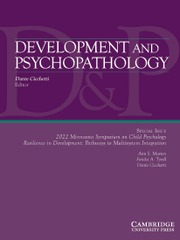Crossref Citations
This article has been cited by the following publications. This list is generated based on data provided by
Crossref.
Ozechowski, Timothy J.
and
Liddle, Howard A.
2000.
Family-Based Therapy for Adolescent Drug Abuse: Knowns and Unknowns.
Clinical Child and Family Psychology Review,
Vol. 3,
Issue. 4,
p.
269.
El-Sheikh, Mona
2001.
Parental drinking problems and children's adjustment: Vagal regulation and emotional reactivity as pathways and moderators of risk..
Journal of Abnormal Psychology,
Vol. 110,
Issue. 4,
p.
499.
Sanford, Mark
2001.
The relationship between antisocial behaviour and substance abuse in childhood and adolescence: implications for aetiology, prevention and treatment.
Current Opinion in Psychiatry,
Vol. 14,
Issue. 4,
p.
317.
Loukas, Alexandra
Fitzgerald, Hiram E.
Zucker, Robert A.
and
von Eye, Alexander
2001.
Parental Alcoholism and Co-Occurring Antisocial Behavior: Prospective Relationships to Externalizing Behavior Problems in their Young Sons.
Journal of Abnormal Child Psychology,
Vol. 29,
Issue. 2,
p.
91.
Young Mun, Eun
Fitzgerald, Hiram E.
Von Eye, Alexander
Puttler, Leon I.
and
Zucker, Robert A.
2001.
Temperamental characteristics as predictors of externalizing and internalizing child behavior problems in the contexts of high and low parental psychopathology.
Infant Mental Health Journal,
Vol. 22,
Issue. 3,
p.
393.
Das Eiden, Rina
Leonard, Kenneth E.
and
Morrisey, Sean
2001.
Paternal Alcoholism and Toddler Noncompliance.
Alcoholism: Clinical and Experimental Research,
Vol. 25,
Issue. 11,
p.
1621.
Twitchell, Geoffrey R.
Hanna, Gregory L.
Cook, Edwin H.
Stoltenberg, Scott F.
Fitzgerald, Hiram E.
and
Zucker, Robert A.
2001.
Serotonin Transporter Promoter Polymorphism Genotype Is Associated With Behavioral Disinhibition and Negative Affect in Children of Alcoholics.
Alcoholism: Clinical and Experimental Research,
Vol. 25,
Issue. 7,
p.
953.
Twitchell, Geoffrey R.
Hanna, Gregory L.
Cook, Edwin H.
Stoltenberg, Scott F.
Fitzgerald, Hiram E.
and
Zucker, Robert A.
2001.
Serotonin Transporter Promoter Polymorphism Genotype Is Associated With Behavioral Disinhibition and Negative Affect in Children of Alcoholics.
Alcoholism: Clinical and Experimental Research,
Vol. 25,
Issue. 7,
p.
953.
Das Eiden, Rina
Leonard, Kenneth E.
and
Morrisey, Sean
2001.
Paternal Alcoholism and Toddler Noncompliance.
Alcoholism: Clinical and Experimental Research,
Vol. 25,
Issue. 11,
p.
1621.
Stoltenberg, Scott F.
Twitchell, Geoffrey R.
Hanna, Gregory L.
Cook, Edwin H.
Fitzgerald, Hiram E.
Zucker, Robert A.
and
Little, Karley Y.
2002.
Serotonin transporter promoter polymorphism, peripheral indexes of serotonin function, and personality measures in families with alcoholism.
American Journal of Medical Genetics,
Vol. 114,
Issue. 2,
p.
230.
Tarter, Ralph E.
Kirisci, Levent
Mezzich, Ada
Cornelius, Jack R.
Pajer, Kathleen
Vanyukov, Michael
Gardner, William
Blackson, Timothy
and
Clark, Duncan
2003.
Neurobehavioral Disinhibition in Childhood Predicts Early Age at Onset of Substance Use Disorder.
American Journal of Psychiatry,
Vol. 160,
Issue. 6,
p.
1078.
Fitzgerald, Hiram E.
Mann, Tammy
Cabrera, Natasha
and
Wong, Maria M.
2003.
Handbook of Psychology.
p.
135.
Zucker, Robert A.
Wong, Maria M.
Puttler, Leon I.
and
Fitzgerald, Hiram E.
2003.
Resilience and Vulnerability.
p.
76.
Zucker, Robert A.
2003.
Preventing Youth Problems.
p.
33.
Molina, Brooke S. G.
and
Pelham, William E.
2003.
Childhood predictors of adolescent substance use in a longitudinal study of children with ADHD..
Journal of Abnormal Psychology,
Vol. 112,
Issue. 3,
p.
497.
Loukas, Alexandra
Zucker, Robert A.
Fitzgerald, Hiram E.
and
Krull, Jennifer L.
2003.
Developmental trajectories of disruptive behavior problems among sons of alcoholics: Effects of parent psychopathology, family conflict, and child undercontrol..
Journal of Abnormal Psychology,
Vol. 112,
Issue. 1,
p.
119.
Hussong, Andrea M.
and
Hicks, Richard E.
2003.
Affect and Peer Context Interactively Impact Adolescent Substance Use.
Journal of Abnormal Child Psychology,
Vol. 31,
Issue. 4,
p.
413.
Edwards, Ellen P.
Eiden, Rina D.
and
Leonard, Kenneth E.
2004.
Impact of fathers' alcoholism and associated risk factors on parent–infant attachment stability from 12 to 18 months.
Infant Mental Health Journal,
Vol. 25,
Issue. 6,
p.
556.
Goldman, David
Oroszi, Gabor
and
Ducci, Francesca
2005.
The genetics of addictions: uncovering the genes.
Nature Reviews Genetics,
Vol. 6,
Issue. 7,
p.
521.
Molina, Brooke S. G.
2005.
Recent Developments in Alcoholism.
Vol. 17,
Issue. ,
p.
49.

